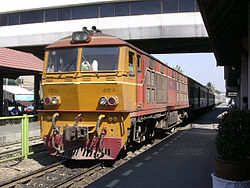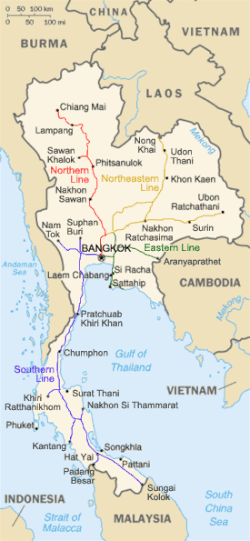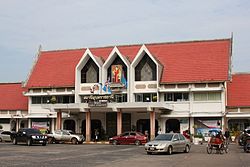State Railway of Thailand
| Thai State Railway การ รถไฟ แห่ง ประเทศไทย State Railway of Thailand |
|
|---|---|
| legal form | public company |
| founding | 1897 |
| Seat | Bangkok |
| Number of employees | 26,412 |
| Branch | Railway company |
| Website | www.railway.co.th |
The Thai State Railway ( Thai การ รถไฟแห่งประเทศไทย , RTGS Kan Rotfai Haeng Prathet Thai , pronunciation: [kaːn rót faj hɛ̀ːŋ pràʔtʰêːt tʰaj] , abbrev. ร ฟ ท.; English State Railway of Thailand , SRT ) is the state railway company of Thailand , the maintains a rail network of 4,487 kilometers. With around 26,000 employees, SRT is the largest state-owned company in Thailand.

history
The Thai State Railway was founded by the State Railway of Thailand Act (BE 2494 of 1951), with the English-language transcription initially Thai State Railway (TSR) being later changed to State Railway of Thailand (SRT). Predecessor organizations were from 1890 the Royal Railway Department (RRD) in the Ministry of Public Works , from 1917 the Royal State Railways (RSR).
In World War II, which was the railway infrastructure on a large scale by the air raids of the Allies destroyed or damaged. Large parts of the route network had to be completely rebuilt in the following years. This took place with the support of the USA after the political situation changed by the Cold War . The USA also supported the construction of new lines. These include the extension of the Northeastern Railway, the railway Nakhon Ratchasima-Nong Khai , the war to Udon Thani had been promoted, and now to the Mekong was extended further a parallel route to the Northeastern Railway, the railway Kaeng Khoi Junction-Bua Yai Junction , the serves to relieve the Nakhon Rachasima junction.
Further new lines were built in the 1980s and 1990s. These serve to connect the new ocean ports on the east coast of the Gulf of Thailand, Laem Chabang and Map Ta Phut to the rail network. This happened with the Chachoengsao Junction – Sattahip railway and its extension into the hinterland, the Khlong Sip Kao – Kaeng Khoi railway , which provides the direct connection from the coast to the Northern Railway and the Northeast Railway.
The last steam locomotives were decommissioned in 1982 and the 100th anniversary of the State Railroad was celebrated on March 26, 1997.
Route network of the Thai railway

Starting from Bangkok, the route network spreads out in a star shape: The SRT route network is predominantly single-track . There are also two- and three-track sections in the Bangkok area. An ambitious expansion program since the end of the last millennium provides for an expansion of four more route sections and the expansion of the single-track areas.
There are seven railway tunnels in the SRT network . The longest is the Khun-Tan-Tunnel on the Northern Railway with 1362 m. There are also 57 railway bridges that are longer than 100 m. The longest is the Bang Pakong railway bridge on the Chachoengsao Junction – Sattahip railway line , the most famous is probably the bridge over the Kwai on the Thailand-Burma railway , the most important in terms of traffic is the Rama VI Bridge in Bangkok. The central hub for passenger traffic is Bangkok Hua Lamphong Station . Trains to and from the south and west usually use Thonburi Station in Bangkok.
Northeast Railway
- The northeast railway to Nakhon Ratchasima with the branch lines:
Eastern Railway
- The Eastern Railway to Aranyaprathet , which used to lead across the Cambodian border to Poipet .
North runway
- The Northern Railway to Chiang Mai with the branch line:
- Ban Dara Junction – Sawankhalok railway line
- The Den Chai – Chiang Rai railway is a project that was pursued and started in 1997–2001, but then got stuck due to lack of funds.
Southern runway
- The southern railway from Thonburi station to Su-ngai Kolok (Amphoe Su-ngai Kolok ) on the border with Malaysia with the branch lines:
- Nong Pladuk Junction – Malai Maen railway line
- Thailand-Burma Railway
- Ban Thung Pho Junction – Khiri Ratthanikhom railway line , a stalled project that was originally supposed to lead to Phuket .
- Thung Song Junction – Kantang railway line
- Hat Yai Junction – Khet Daen (border crossing to Malaysia ). International trains run from here to Singapore via Butterworth and Kuala Lumpur .
Eastern coastline
- Chachoengsao Junction – Sattahip railway line and its extension into the hinterland:
- Khlong Sip Kao – Kaeng Khoi railway line
Thonburi – Samut Songkhram railway line
The Thonburi – Samut Songkhram railway is a two-part island operation in the south-west of Bangkok, with no connection to the rest of the railway network.
Suvarnabhumi Airport Rail Link
This S-Bahn is operated on its own track structure - mostly as an elevated railway - by a subsidiary of SRT, the SRT Electrified Train (SRTET). It connects Bangkok's Suvarnabhumi Airport with downtown Bangkok.
Projects
1990-1998 the project of the Bangkok Elevated Road and Train System (BERTS) was tried with the participation of the SRT. The combined elevated railway and urban motorway system was to be built over the existing railway lines in Bangkok and relieve the collapsing road traffic in the Thai capital. It collapsed in the Asian financial crisis in 1998, leaving behind bizarre building ruins, which were largely removed in the following 15 years. 1997–2001 began to build the Den Chai – Chiang Rai railway. The project got stuck due to a lack of money.
In March 2011, Thailand signed a letter of intent with the Chinese government to build a high-speed line between Kunming and Singapore . However, the plan was abandoned again in 2012.
In the future, Bangkok's Hua Lamphong train station will be replaced by a new Bang Sue Central Station , which is due to open in January 2021. It will also replace the two train stations in the Bang Sue district . With 26 tracks, it will be the largest train station in the ASEAN member states . In addition, long -distance passenger rail transport and local public transport will be linked. The entrance building of the Hua Lamphong train station will then continue to be used as a museum and tourist attraction.
Travel offers

The Thai State Railways offers three classes , with the 2nd class being offered in different comfort (and price) variants:
- Class is only available as air-conditioned sleeping cars in night trains. There are compartments with two beds on top of each other and washing facilities. A compartment can also be booked for one person for a surcharge. The beds can be folded down into a bench. Two compartments are connected to each other by an intermediate door and can therefore also be used together. On some routes, dinner and breakfast can be served in the compartment. Toilets are located at the end of the car, also in European design.
- Class is available as a sleeping car with or without air conditioning and as a seating car with and without air conditioning. In the sleeping car, the beds are arranged on both sides along a central aisle, from which they are separated by a curtain at night. The upper bed is folded up during the day, the lower one folded into two opposite seats. The upper bed is a bit cheaper but also a bit narrower than the lower one. At the end of the car there is a washroom and toilets in both European and Thai versions. In long-distance high-speed traffic with the “Special Express / DRC” train type , which is driven with diesel multiple units built by Daewoo in the 1990s , only air-conditioned 2nd class is offered in seated cars.
- Class is only available as a seated car. Today these mostly have upholstered seats. However, wagons with wooden benches are also used. As a rule, 3rd class is not air-conditioned. The exception are some air-conditioned cars on long-haul routes. Top offers in long-distance transport do not lead to 3rd class.
- There are also dining cars in long-distance trains in both air-conditioned and non-air-conditioned versions.
Since July 11, 2014, the sale and consumption of alcoholic beverages on trains and stations has been banned. All trains are non-smoking trains.
In addition to the regular traffic, there are some tourist offers. These include the Eastern and Oriental Express , which runs on SRT routes but is not operated by it, and tourist trains on weekends to Kanchanaburi and Nam Tok Sai Yok Noi .
literature
- R. Ramaer: The Railways of Thailand . White Lotus Co Ltd, Bangkok 2009, ISBN 978-974-480-151-7
- BR Whyte: The Railway Atlas of Thailand, Laos and Cambodia . White Lotus Co Ltd, Bangkok 2010, ISBN 978-974-480-157-9
Web links
Individual evidence
- ↑ SRT history ( Memento of the original from May 12, 2013 in the Internet Archive ) Info: The archive link was inserted automatically and has not yet been checked. Please check the original and archive link according to the instructions and then remove this notice. (English, accessed on May 12, 2012)
- ^ Whyte: Railway Atlas. P. 2.
- ^ Whyte: Railway Atlas. P. 2.
- ^ Whyte: Railway Atlas. P. 4.
- ^ Whyte: Railway Atlas. P. 4.
- ↑ Plan of the route network of the SRT ( Memento of the original from July 4, 2013 in the Internet Archive ) Info: The archive link was inserted automatically and has not yet been checked. Please check the original and archive link according to the instructions and then remove this notice. (Terms in English and Thai)
- ↑ Listed in Whyte: Railway Atlas. P. 84f.
- ↑ Listed in Whyte: Railway Atlas. P. 86.
- ↑ Listed in Whyte: Railway Atlas. P. 87ff.
- ↑ Press release on the construction stop ( Memento of the original from February 5, 2013 in the web archive archive.today ) Info: The archive link was automatically inserted and not yet checked. Please check the original and archive link according to the instructions and then remove this notice.
- ↑ Thailand: New high-speed line planned . Eurailpress, March 29, 2011.
- ↑ Bang Sue mega-station to operate by January 2021
- ^ How Southeast Asia's Largest Railway Station Will Impact Bangkok Real Estate . In: ThailandBusinessNews.com . March 7, 2018. Retrieved May 2, 2018.
- ^ Thai Railway Guide. Effective October 1, 2015, p. 18. ( fahrplancenter.com ).
- ↑ Information from: The Man in Seat 61: Train Travel in Thailand .




